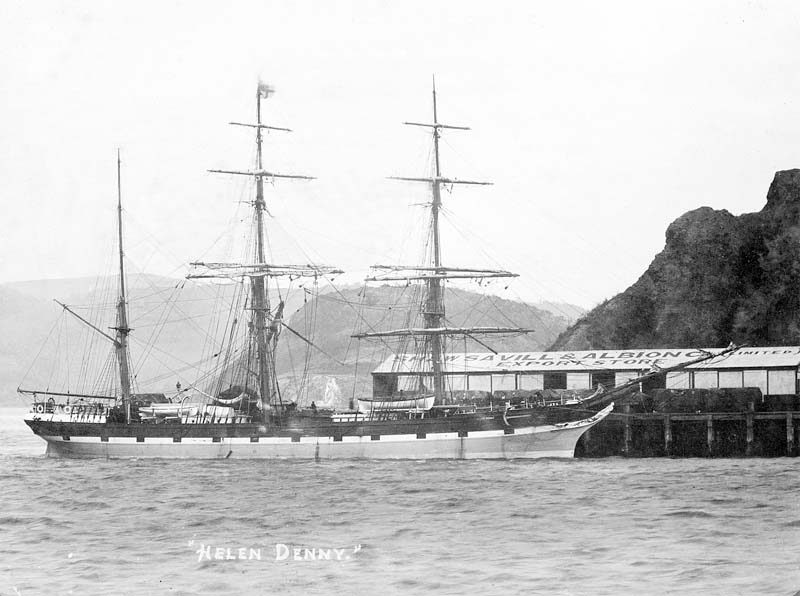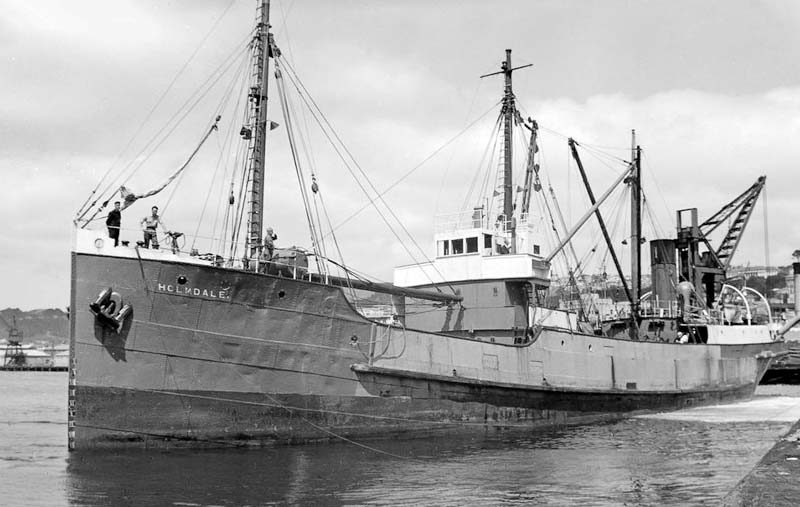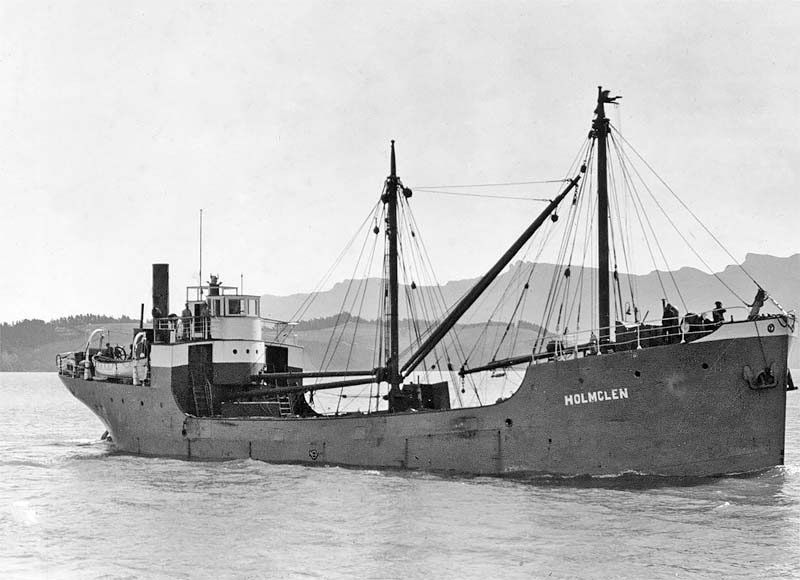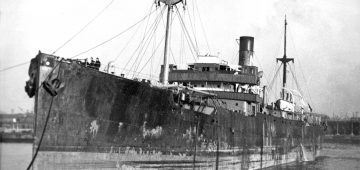The Green Funnelled Kiwi Fleet

 This company was first registered on 3rd December 1926 to bring together two small steam coasters trading on the coast, and a four masted American built schooner bringing coal cargoes across the Tasman Sea to Wanganui, and all previously registered under separate companies. The Holm Shipping Co. Ltd. was to last for over fifty years and become famous in the South Pacific trades, to Norfolk Island, and as a lifeline to the Chatham Islands, 467 miles east of South Island, and the Kermadec Islands, 650 miles north of Auckland, as well as the occasional charter to the Australian National Antarctic Research Expedition (ANARE) for Antarctic supply voyages. During the 65 years of trading, all of the owned vessels had a common nomenclature beginning with ‘Holm’ e.g. Holmdale, Holmwood, Holmlea, Holmburn, Holmglen, Holmbank, Holmbrae and Holmpark. The motor coaster Holmdale of 911 grt was completed at Martenshoek in Holland in 1961 and traded for the company for thirty years between New Zealand and the Cook, Chatham and Kermadec Islands to earn herself a place in the maritime history annals of the Antipodes.
This company was first registered on 3rd December 1926 to bring together two small steam coasters trading on the coast, and a four masted American built schooner bringing coal cargoes across the Tasman Sea to Wanganui, and all previously registered under separate companies. The Holm Shipping Co. Ltd. was to last for over fifty years and become famous in the South Pacific trades, to Norfolk Island, and as a lifeline to the Chatham Islands, 467 miles east of South Island, and the Kermadec Islands, 650 miles north of Auckland, as well as the occasional charter to the Australian National Antarctic Research Expedition (ANARE) for Antarctic supply voyages. During the 65 years of trading, all of the owned vessels had a common nomenclature beginning with ‘Holm’ e.g. Holmdale, Holmwood, Holmlea, Holmburn, Holmglen, Holmbank, Holmbrae and Holmpark. The motor coaster Holmdale of 911 grt was completed at Martenshoek in Holland in 1961 and traded for the company for thirty years between New Zealand and the Cook, Chatham and Kermadec Islands to earn herself a place in the maritime history annals of the Antipodes.

Early Holm Beginnings
Capt. Ferdinand Holm was born in Arboga in Sweden in 1844 into a family of deep sea seafarers voyaging around the world, and he arrived in a sailing ship in Australia and New Zealand in 1868. He then rose to command sailing ships sailing out of Wellington and also worked as a Wellington pilot. He put aside sums of money into savings in order to become a part owner in sailing ships on the 64ths system of ownership, commanding six sailing ships between 1880 and 1915 with part, half or full shares owned. He was very much a sailing ship man, never commanding steamers, and he voyaged extensively across the South Pacific, across the Tasman Sea to Australia, and in the Indian Ocean to Calcutta, Tamatave (Madagascar), Mauritius, and the Dutch East Indies. Capt. Holm often took his wife Mary and one or more of his large family of four sons and five daughters on these voyages. Two of his sons became well respected Master Mariners in their own right, Capt. Sydney Holm and Capt. Mariner Holm, with the other two sons becoming marine engineers.
There are surviving photographs of the crew of 17 of the barque Helen Denny of 728 grt, completed in 1866 at Port Glasgow for the Albion Line of Paddy Henderson, showing Capt. Sydney Holm in command of the vessel along with his brother Mariner Holm and his daughter Phyllis. This famous sailing ship made a dozen voyages to Rangoon and the Far East before being transferred to the New Zealand trade in 1874. She then made 21 voyages to New Zealand between 1874 and 1896 and was purchased by Capt. Ferdinand Holm in 1900. He and his son Capt. Sydney Holm became joint owners in 1907 and this barque was then sold to the Paparoa Coal Mining Company of Wellington in 1913 but was withdrawn from intercolonial trade in the following year and hulked.

Capt. Ferdinand Holm at the age of 68 years purchased the British four masted barquentine Titania of 1,107 grt in 1912, completed in 1895 by Russell & Company of Port Glasgow for the New Zealand trade. Titania soon became his favourite ship of all of the sailing ships he commanded and owned, sailing her to the Pacific islands and to Australia. A voyage to Suva was made in July 1914 with Mariner Holm joining the crew here as Third Officer. After discharge of her Wellington cargo, she was routed to the French owned Surprise Island to load a cargo of guano. Capt. Holm then found he had to call at Noumea at the southern tip of the French owned island of New Caledonia to clear the ship’s papers. The French Government had given orders on the outbreak of war on 4th August 1914 to extinguish all lights in the Pacific including that at Noumea marking a ten mile reef on the entry to the port. Mariner Holm went aloft when they approached Noumea but could see no light until the masthead light of the Australian cruiser HMAS Australia was seen. Capt. Holm assumed this must be from the lighthouse but orders were then received from the cruiser to ‘stand in’ and wait until daylight. While manoeuvring to carry out these orders, Titania was swept by a huge wave and landed on the shore close to the lighthouse, and daylight showed another three sailing ships had piled onto the rocks during the night, all as a result of the French Government decision to extinguish the light. All hands were rescued from Titania with Capt. Ferdinand Holm and Mariner Holm arriving in Noumea harbour in a small boat towed by a steamer.

Hamasamicho while on a voyage from Kurosaki to Naoyetsu with a cargo of coke.
Capt. Ferdinand Holm lived at Patanga Crescent in Wellington, and only commanded one more ship in his life, the old barque Antiope, built in 1866 by John Reid at Port Glasgow and which had traded between the West Coast of America and Australasia. Mariner Holm joined her at Sydney for a voyage as Second Officer to Europe with coal, returning with timber to Sydney. When she returned to Sydney in the summer of 1915, her owners were in financial difficulties and Capt. Holm sailed to Sydney to inspect her with a view to purchase. After sailing the old barque into Wellington in September 1915, Capt. Ferdinand Holm retired from the sea and died later in 1917 at the age of 73 years.


Subscribe today to read the full article!
Simply click below to subscribe and not only read the full article instantly, but gain unparalleled access to the specialist magazine for shipping enthusiasts.





Comments
Sorry, comments are closed for this item